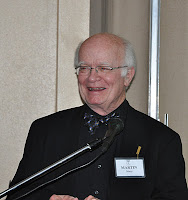Atheism in America -- Sightings
As the debate continues to rage as to whether the United States is a secular nation or a Christian one -- or something in between -- reality is rather complicated. Martin Marty picks up from where he left off in last week's posting to continue exploring the varieties of our belief and unbelief, culminating in a few comments on the reality of our practical atheism -- the fact that despite the posturings of many, we tend to live our lives without giving all that much thought to whether or not God exists. Take a read, offer a comment!
*********************************
Sightings 12/12/2011
-- Martin E. Marty
Picking up from where we left off last week on "practical atheism:" Atheism shows up in our Sightings on occasion, partly as a refreshing alternative to the over-covered examples of “religion-in-American-public-life” which crowd the cable television channels and headlines: you know, like stories of the piety of quarterback Tim Tebow or the pieties of presidential candidates. The public which wants to sort out the elements of the religious spectrum has reason also to look for atheism, anti-belief, un-belief, “nones” (in respect to religious preference) and all the rest. Analyzing this spectrum has kept sociologists of religion, historians, and journalists occupied.
At the heart of the American inquiry, unlike the search in officially atheistic nations like China (where religion thrives, if mainly underground), is the search for boundaries among population cohorts. How can the United States be what some have noticed, “the first secular nation,” at the same time that it is “hyper-religious” in the eyes of others, notably European visitors? Pollsters are creatively busy as they listen to and observe these populations. Do the old definitions hold? Rice University sociologist Elaine Howard Ecklund caught many an eye with her scholarly papers and media appearances. Ecklund’s “Atheists and Agnostics Negotiate Religion and Family” in theJournal for the Scientific Study of Religion gave her space to develop her case, and an important one it is. Her Science vs. Religion is a recent notable and well-noted book in this field.
What I take from her work is a caution lest citizens fall into the trap of over defining. The hyper-theistic make up a larger number than the hyper-atheistic, but both speak with similar incaution, for example between quarterback snaps in the theistic case and in most utterances of “the new atheists” on the other. Ecklund finds that one in five polled or interviewed atheist scientists with children “involve their children with religious institutions.” One is tempted to say that that is probably about the same percentage of non-atheist non-scientists. Why do scientists “practice” religion even at second-hand? Some see it as a carry-over from childhood training, in the spirit of Hilaire Belloc: “So always keep a-hold on nurse for fear of finding something worse.” Mild “involvement” with religious institutions is a safe way to hedge bets or develop quiet habits. Ecklund and others in her generation are making a fresh run and exploring all this.
I’ve long, very long, been observing what I call “practical atheism” in religious institutions or in the penumbra of social circles around them. Fifty-five years ago next Thursday—I can’t resist noting—I got a Ph.D. for tracking “the varieties of unbelief.” Having set out to find the hidden skeptics of stature that I thought must have lurked in our national past—the Nietzsches or Marxes or other titanic “god-killers”--and finding mainly humorists (a la Mark Twain, always worth a reading) or inventors of new faiths that were not called faiths, it has struck me that what goes on in a blurry-lined set of publics is that millions do not bother to fight God or strongly to affirm God but to act the same way whether or not God exists. That way of living, not always “bad faith,” can be a way of keeping options open, being honest about the mystery of faith and the mystery of non-faith. You’ll hear and see evidences of both in this Christmas season. Let the carols and secular jingles both ring! They will, whether you bid them to, or not.
References
Dan Merica, “Study: Some atheists with children attend religious services, ” CNN Belief Blog, December 7, 2011.
Elaine Howard Ecklund's webpage on the Rice University website is at:
Martin E. Marty's biography, publications, and contact information can be found at www.memarty.com.
----------
In this month’s Religion and Culture Web Forum, Emanuelle Burton’s “Whose Lion Is It, Anyway?” argues that scholarly commentary on C.S. Lewis’ Chronicles of Narnia is too dominated by the Christian academy; thus, it often fails to understand (or to serve) a major portion of the books’ audience: readers who are uninterested in, or even disturbed by, the Chronicles’ “parallels to the Christian salvation story.” Writes Burton, “Simply put, it is time for Narnia criticism to broaden its horizons: to acknowledge a wider array of readers, and to take seriously the question of what draws so many readers to the books without drawing them closer to Christianity.”
----------
Sightings comes from the Martin Marty Center at the University of Chicago Divinity School.


Comments